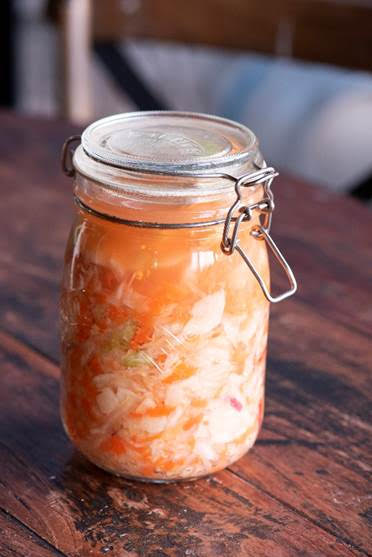The best tips for taking care of your digestive health during the festive season
With the festive season fast approaching, the goose may not be the only one in danger of gaining weight! How do we help our bodies survive the weeks of heavy food and alcohol as we celebrate Christmas?
Award-winning nutritionist and gut health expert Dr. Lucy Williamson believes the gut microbiome is at the heart of a healthy body and mind, so taking care of our gut health ensures we survive the excesses of the season!
“The holiday season is a wonderful time to gather with friends and family, and we all tend to cram more socializing into that two-week period than any other time of year. Indispensable party food and festive glasses of alcohol affect not only digestion, but also sleep patterns and moods. However, paying a little extra attention to gut health can help us get through and enjoy Christmas while we prepare for the demands of the New Year and winter!”
Here are Lucy’s top tips for looking after your digestive health over Christmas:
- Alcohol – A glass of red wine can be beneficial for gut health, as it contains antioxidants that our good guts love! For this same reason, cider can also be a good choice, as apple peels also have plenty of antioxidants. However, balance is of course key……why not try mixing it up on alcohol free days and enjoy a sophisticated glass of bubbly tea – these Kombuchas may still feel like a lovely treat, but give your liver a break! They’re also low in sugar, which helps ease your waistline when you’re partying (we often forget that red wine, cider, beer, etc. are high-sugar drinks), and a natural probiotic can support our digestive system, too. (Reminder that the recommended weekly alcohol intake for men and women is 14 units. This is equivalent to approximately 1 pint of beer or cider per day or 1 glass of red wine per day)
- Sleep – Christmas is such a busy time, but we know that sleep is vital for the health of our gut microbiome and digestive tract. This is partly due to its effect on the gut-brain axis – the pathway by which our gut affects our emotional well-being. If you find it hard to get your 8 hours, try a power tower at lunchtime – our natural circadian rhythm really wants us to do this! If you want to get rid of excessive tension, try, for example, a short walk, stretching in the garden or a 10-minute breathing meditation.
- Eat late – We all love to party – which means eating later and less overnight fasting, which can really disrupt the gut brain axis, gut health and digestion. If you ate late the night before, try to make up for this by eating breakfast much later the next day so that you still get at least 12 hours of fasting.
- Probiotic foods – eating these little and often can really help balance our good gut microbes – a small glass of kefir half an hour before breakfast, replace your seasonal vinaigrette with raw apple cider vinegar, keep sauerkraut in the fridge; it’s a great side dish for your party cheese board – you can easily make these at home too – try my recipe below
- Liver – squeeze in the love with high-quality protein – fish and chicken are good choices, or try lovely lentils, legumes and beans for high-quality plant-based protein, like in a warming bean chili bowl
- Plant variety – a good way to keep your gut happy is to remember to include as many plant varieties as possible in all meals. 30 plants per week is ideal. Here are some easy ways to do this:
- Nuts and seeds sprinkled on a breakfast bowl, soup or roasted vegetable.
- Remember that there are also 30 spices and herbs per week, so enjoy these ingredients in your favorite party recipes, like leftover turkey in a tasty curry!
- Make simple vegetarian dishes especially delicious by adding additional ingredients, e.g
- fried leeks with quickly prepared peas,
- winter herbs added to potatoes and roasted vegetables,
- season the potatoes with a wonderful mixture of herbs such as mint, parsley and oregano,
- try homemade green pesto to use with pasta in emergencies
- add fiber to your morning porridge – I like to use chia seeds, barley flakes, puffed quinoa and a touch of cinnamon with the oats, so it’s a five-plant porridge!
Lucy has provided some recipes to nurture your gut microbiome between parties:
Homemade ferment

Makes 1 quart
Preparation time:
Cooking time:
You will need:
1l glass jar
1 large ceramic or glass bowl
A sharp knife
Ingredients:
NOTE: If you can, use organic fruits and vegetables for best results.
- 500 g of white cabbage and 500 g of carrot
- 1 red peeled apple.
- 2 cm piece of ginger
- 2 tablespoons of sea salt
Method:
- Sterilize your jar – rinse well with hot soapy water and place in an oven preheated to 140 degrees for at least 10 minutes. Allow to cool completely before use. Make sure all other equipment is very clean. Remove jewelry.
- Thinly slice the cabbage, apple and carrot – I use a spiralizer for the carrot, but you can also grate it. In your large bowl, mix with the salt. Press down well to release as much liquid as possible – this will take about 15 minutes before you add the salt to the vegetables and press as you go. You aim for the shredded vegetable to be limp and easy to squeeze out the water. Add thinly sliced ginger.
- Transfer to the glass jar a little at a time, pressing each addition into the jar so that its water remains submerged. Once all the vegetables are in the jar, make sure they are completely submerged – you can fill the space between the vegetable mixture and the lid with a piece of cabbage stalk to keep the vegetables submerged when sealed.
- Let it ferment at room temperature (out of direct sunlight) for 1-4 weeks. After opening, refrigerate and enjoy within 4 weeks if it lasts that long!
- Serve as a side dish with salads, a quinoa lunch bowl, or cheese and crackers.
A WARM PAPPUCHILLI
A wonderful variety of plants for gut health, including spices and herbs, all covered in 30 weeks! Beans and legumes are also a good source of protein, and buying them dry saves money.
Serves 4
Preparation time 10 min
Cooking time 20 minutes (the beans must be soaked overnight)
Ingredients
150g mixed dried beans, e.g. Red Fox Carlin/ Yellow Pea/ Red neeru
2 small red onions
4 cloves of garlic
2 cans of chopped tomatoes
2 red peppers
4 fresh chilies, chopped and seeds removed
1 bunch coriander
2 teaspoons dried coriander
2 teaspoons of dried cumin
2 teaspoons of smoked paprika
Cold-pressed rapeseed oil
Method
- Soak dried beans in water overnight. Change the water the next day and cook the beans according to the instructions.
- Slice and grill the red peppers until they turn slightly black.
- Slice one red onion and grate two cloves of garlic. Sweat in a pan with cold-pressed rapeseed oil over low heat.
- Add the tomatoes and 50 ml of water to the onions. Add cumin, smoked paprika and salt and pepper to taste.
- Mix fresh chili with coriander stalks, 2 cloves of garlic and half a red pepper to make a fresh chili paste.
- Season the sauce and add fresh chili paste. Add the cooked beans and check the seasoning again. Slice the rest of the peppers and add to the mixture. If you want, you can add cumin/paprika to taste.
- Serve with chopped cilantro leaves and Greek yogurt.
WATER CRESS & SPINACH PESTO
This is a great skill to quickly get used to cooking at home, as it can add flavor to a wide variety of dishes, from risotto to fried fish or grain bowls.
Makes 1 medium jar
Keeps in the fridge for 1 week
Preparation time:
Cooking time
INGREDIENTS:
- 25 g watercress (including stems)
- 50 g of spinach
- 50 g frozen peas, cooked
- 2 small garlic cloves
- 20 g of grated (or crushed) parmesan
- 25 g pecans (or walnuts for a more bitter taste)
- 50 ml extra virgin olive oil
- A squeeze of lemon juice
- Salt and pepper to taste
METHOD:
- Wash the leaves and mix half of them with all the other ingredients
- Add the rest of the leaves and blitz to a thick paste
- Store in a sterilized recycled jar – add a layer of olive oil to prevent the pesto from discolouring when exposed to air and add a lid
OPTIONAL/ALTERNATIVE
- Experiment with other leaves in season – basil and arugula are also good in pesto
- Go to nutrition! Young wild leaves such as stinging nettle and wild garlic mustard add enormous flavor and nutrients
Interesting!
There is growing evidence for the benefits of bitter taste in foods – watercress, walnuts and other bitter leaves not only add great taste, but the nutrients that provide this bitter taste also help our natural appetite mechanism work well (feeling full). and also deliver age-defying antioxidants!
So go ahead – give yourself a fun little Christmas, but reserve your thoughts and Donate it nourishing food between parties!
For more advice on nutrition and gut health, visit www.lwnutrition.co.uk
Gino D’Acampo Leeds is launching a new menu


